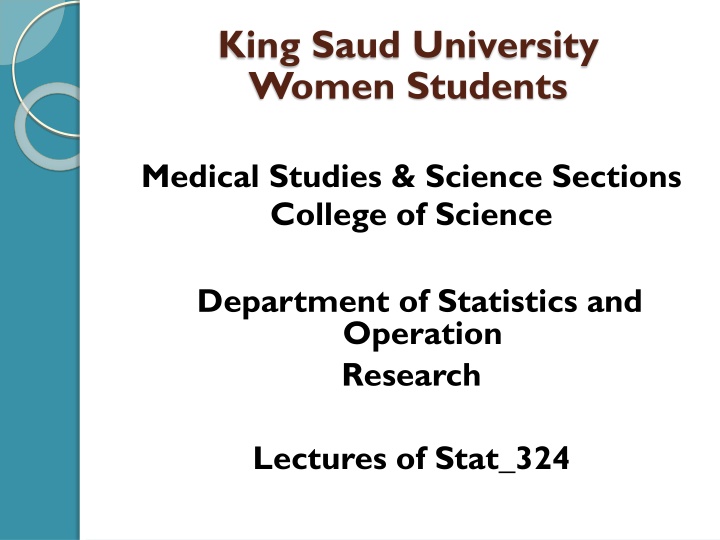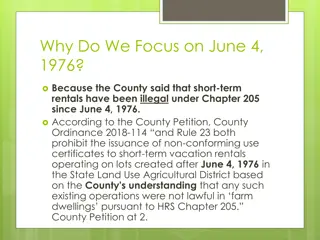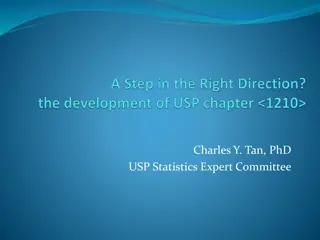
Probability Distributions and Bernoulli Trials Overview
Explore the concepts of discrete probability distributions including the Discrete Uniform Distribution, Bernoulli Distribution, and more. Understand key theorems, mean, variance calculations, and practical examples like tossing a coin. Enhance your understanding of statistics in a structured manner.
Download Presentation

Please find below an Image/Link to download the presentation.
The content on the website is provided AS IS for your information and personal use only. It may not be sold, licensed, or shared on other websites without obtaining consent from the author. If you encounter any issues during the download, it is possible that the publisher has removed the file from their server.
You are allowed to download the files provided on this website for personal or commercial use, subject to the condition that they are used lawfully. All files are the property of their respective owners.
The content on the website is provided AS IS for your information and personal use only. It may not be sold, licensed, or shared on other websites without obtaining consent from the author.
E N D
Presentation Transcript
King Saud University Women Students Medical Studies & Science Sections College of Science Department of Statistics and Operation Research Lectures of Stat_324
CHAPTER FOUR SOME DISCRETE PROBABILITY DISTRIBUTIONS
4.1 Discrete Uniform Distribution: If the random variable X assume the values with equal probabilities, then the discrete uniform distribution is given by: 1 K = = ( , ) , , ,..., P X K X x x x 1 2 K = 0 ) 1 ( elsewhere
Theorem: The mean and variance of the discrete uniform distribution are: ) , ( K X P K = K = 2 ( ) X X i 2 1 K 1 i i = = , ) 2 ( K
EX (1): When a die is tossed once, each element of the sample space occurs with probability 1/6. Therefore we have a uniform distribution with: 6 , 5 , 4 , 3 , 2 , 1 { = } S 1 = = ( 6 , ) , , 1 2 , 3 , 4 , 5 , 6 P X X 6 Find: 1. 2. 3. (1 4) P x P x (3 P ( 3) 6) x
Solution: 1. (1 4) = P x 1 6 1 6 1 6 3 6 = + = + = = + + = ( 1) ( 2) ( 3) P x P x P x 2 6 2. = = + = = ( 3) ( 1) ( 2) P x P x P x 2 6 3. = = + = = (3 6) ( 4) ( 5) P x P x P x
EX (2): and 2 For example (1): Find Solution: k X + + + + + i 1 2 3 4 5 6 6 = = = = 3.5 1 i k k 2 ( ) X i = 2 = 1 i k (1 3.5) + (2 3.5) + (3 3.5) + (4 3.5) + (5 3.5) + (6 3.5) 2 2 2 2 2 2 35 12 = = 6
4.2 The Bernoulli Distribution: Bernoulli trials are an experiment with: 1) Only two possible outcomes. 2) Labeled as success (S), failure (F). 3) Probability of success , probability of failure . 1 ( q p p q = = + = = p 1)
Theorem: Bernoulli distribution has the following function: = = 1 X X ( ) , 0,1 (3) f x p q x The mean and the variance of the Bernoulli distribution are: = = 2 (4) p and pq
Ex (3): Toss a coin and let the random variable x get a head, find: 1. 2. , P x = ( 1) 2 Solution: ( P H = = = = = ) 1/2, 1/2 x H q P x = = = 0 ( 1) (1/2)(1/2) 1/2 = = = 2 1/2, (1/2)(1/2) 1/4 p pq
4.2.1 Binomial Distribution: The probability distribution of the binomial random variable X, the number of successes in n independent trials is: n n X = = X ( , , ) b x n p , 0,1,2,...., (5) p q x n x
Theorem: The mean and the variance of the binomial distribution b(x, n, p) are: = = 2 (6) np and npq *The Binomial trials must possess the following properties: 1) The experiment consists of n repeated trials. 2) Each trial results in an outcome that may be classified as a success or a failure. 3) The probability of success denoted by p remains constant from trial to trial. 4) The repeated trials are independent. 5) The parameters of binomial are n,p.
EX (4): According to a survey by the Administrative Management society, 1/3 of U.S. companies give employees four weeks of vacation after they have been with the company for 15 years. Find the probability that among 6 companies surveyed at random, the number that gives employees 4 weeks of vacation after 15 years of employment is: a) anywhere from 2 to 5; b) fewer than 3; c) at most 1; d) at least 5; e) greater than 2; f) calculate and 2
Solution: = = = 6, 1/3, 2/3 n p q = = + = + = + = ( ) (2 a P 5) ( 2) ( 3) ( 4) ( 5) x P x P x P x P x 6 6 6 6 2 4 3 3 4 2 5 1 1 3 2 3 1 3 2 3 1 3 2 3 1 3 2 3 = + + + 2 3 4 5 240 729 160 729 60 729 12 729 472 729= = + + + = 0.647 = = + = + = ( ) ( b P x 3) ( 0) ( 1) ( 2) P x P x P x 6 6 6 0 6 1 5 2 4 1 3 2 3 1 3 2 3 1 3 2 3 = + + 0 1 2 64 729 192 729 240 729 496 729 = + + = = 0.68
= = + = ( ) c P x ( 1) ( 0) ( 1) P x p x 6 6 0 6 1 5 1 3 2 3 1 3 2 3 = + 0 1 64 729 192 729 256 729 = + = = 0.351 = = + = ( ) d P x ( 5) ( 5) ( 6) P x P x 6 6 5 1 6 0 1 3 2 3 1 3 2 3 = + 5 6 12 729 1 13 729 = + = = 0.018 729
2) 1 = = = + = + = ( ) ( e P x ( 2) ( 0) ( 1) ( 2) P x P x P x P x 6 6 6 0 6 1 5 2 4 1 3 2 3 1 3 2 3 1 3 2 3 = + + 1 0 1 2 64 729 192 729 240 729 496 729 233 729 = + + = = = 1 1 0.319 1 3 6 3 2 3 = = = = ( ) f (6)( ) 2 np 1 3 12 9 = = = = 2 (6)( )( ) 1.333 npq
EX (5): The probability that a person suffering from headache will obtain relief with a particular drug is 0.9. Three randomly selected sufferers from headache are given the drug. Find the probability that the number obtaining relief will be: a) exactly zero; b) at most one; c) more than one; d) two or fewer; e) Calculate 2 and
Solution: 0.9, p = = = 3, 0.1 n q 0) 3 ( ) ( ) 0 3 = = = ( ) ( a P X 0) 0.9 0.1 0.001 0 = = + = ( ) ( b P x 1) ( ( 1) P x P x 3 3 ( ) ( ) ( ) ( ) 0 3 1 2 = + 0.9 0.1 0.9 0.1 0 1 = 0.001 0.027 + = 0.028
= 1 [ ( = = + = ( ) ( c P X 1) 1 ( 1) 0) ( 1)] p x P x P x 3 3 ( ) ( ) ( ) ( ) 0 3 1 2 1 [ = + 0.9 0.1 0.9 0.1 0 1 1 (0.001 0.027) = + 1 0.028 = = 0.972 = = + = + = ( ) ( d P x 2) ( 0) ( 1) ( 2) P x P x P x 3 3 3 ( ) ( ) ( ) ( ) ( ) ( ) 0 3 1 2 2 1 = + + 0.9 0.1 0.9 0.1 0.9 0.1 0 1 2 = 0.001 0.027 0.243 0.271 + + =

















